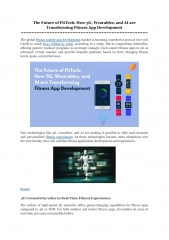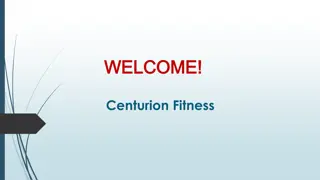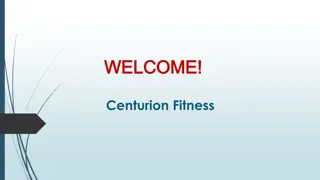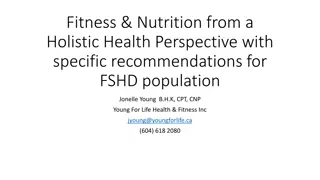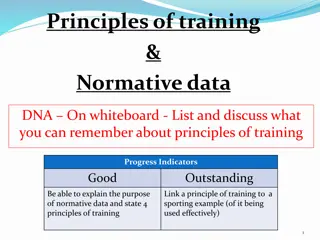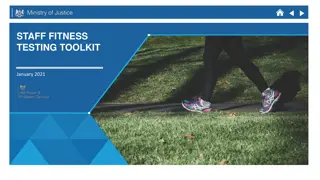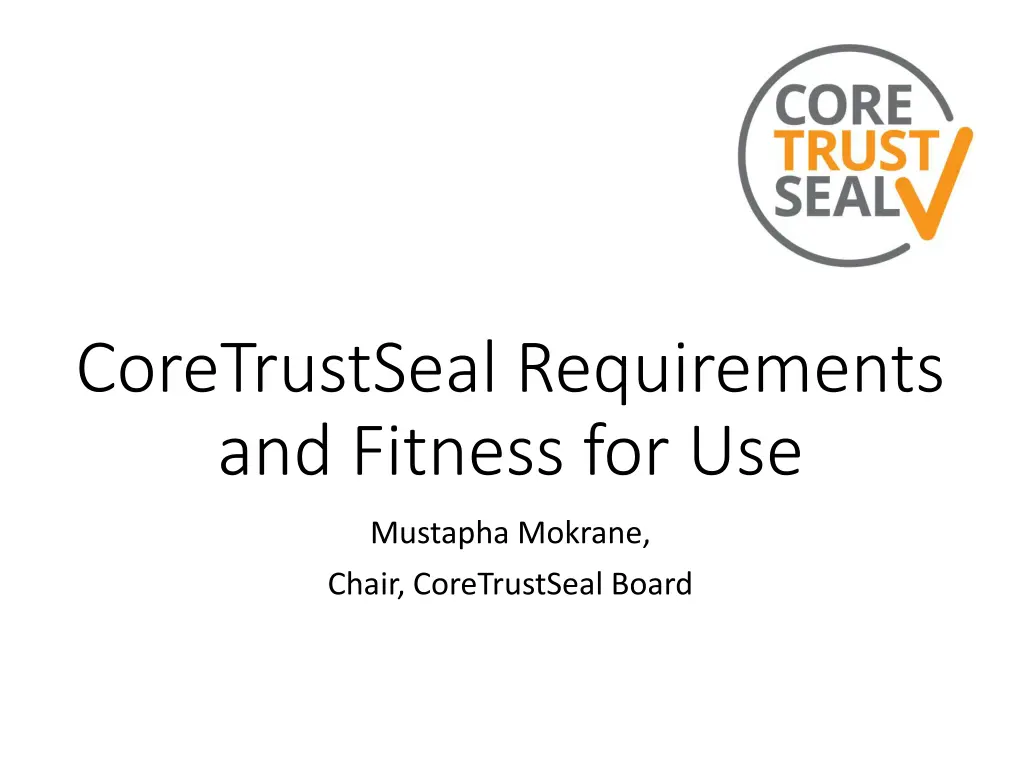
CoreTrustSeal Certification Requirements and Procedure
CoreTrustSeal offers certification for data repositories based on specified requirements. The process involves fulfilling 16 organizational, digital object management, and technological criteria. Applications undergo peer review before certification is granted for a period of three years.
Download Presentation

Please find below an Image/Link to download the presentation.
The content on the website is provided AS IS for your information and personal use only. It may not be sold, licensed, or shared on other websites without obtaining consent from the author. If you encounter any issues during the download, it is possible that the publisher has removed the file from their server.
You are allowed to download the files provided on this website for personal or commercial use, subject to the condition that they are used lawfully. All files are the property of their respective owners.
The content on the website is provided AS IS for your information and personal use only. It may not be sold, licensed, or shared on other websites without obtaining consent from the author.
E N D
Presentation Transcript
CoreTrustSeal Requirements and Fitness for Use Mustapha Mokrane, Chair, CoreTrustSeal Board
CoreTrustSeal CoreTrustSeal offers to any interested data repository a core level certification based on the CoreTrustSeal Data Repositories Requirements.
CoreTrustSeal Data Repository Certification 16 Requirements Context Organizational infrastructure (R1-6) Digital object management (R8-14) Technology (R15-16) Applicant feedback https://doi.org/10.17026/dans-22n-gk35
Compliance levels 0 Not applicable 1 The repository has not considered this yet 2 The repository has a theoretical concept 3 The repository is in the implementation phase 4 The guideline has been fully implemented in the repository .. to foster the applicants own understanding of the current status/maturity of their repositories
Certification Procedure: 2 steps 1. Online application based on 16 Requirements (URLs of documented public evidence + compliance level) with extended guidance 2. Peer review by two expert and independent reviewers under the responsibility of the CoreTrustSeal Standards and Certification Board Successful applications are made publicly available Certification valid 3 years
Organisational infrastructure R1. The repository has an explicit mission to provide access to and preserve data in its domain. R2. The repository maintains all applicable licenses covering data access and use and monitors compliance. R3. The repository has a continuity plan to ensure ongoing access to and preservation of its holdings. R4. The repository ensures, to the extent possible, that data are created, curated, accessed, and used in compliance with disciplinary and ethical norms. R5. The repository has adequate funding and sufficient numbers of qualified staff managed through a clear system of governance to effectively carry out the mission. R6. The repository adopts mechanism(s) to secure ongoing expert guidance and feedback (either in-house, or external, including scientific guidance, if relevant).
Digital object management R7. The repository guarantees the integrity and authenticity of the data. R8. The repository accepts data and metadata based on defined criteria to ensure relevance and understandability for data users. R9. The repository applies documented processes and procedures in managing archival storage of the data. R10. The repository assumes responsibility for long-term preservation and manages this function in a planned and documented way.
Digital object management R11. The repository has appropriate expertise to address technical data and metadata quality and ensures that sufficient information is available for end users to make quality-related evaluations. R12. Archiving takes place according to defined workflows from ingest to dissemination. R13. The repository enables users to discover the data and refer to them in a persistent way through proper citation. R14. The repository enables reuse of the data over time, ensuring that appropriate metadata are available to support the understanding and use of the data.
Technical infrastructure R15. The repository functions on well-supported operating systems and other core infrastructural software and is using hardware and software technologies appropriate to the services it provides to its Designated Community. R16. The technical infrastructure of the repository provides for protection of the facility and its data, products, services, and users.
CoreTrustSeal and FAIR Metrics R13. The repository enables users to discover the data and refer to them in a persistent way through proper citation. Does the repository offer search facilities? Does the repository maintain a searchable metadata catalogue to appropriate (internationally agreed) standards? Does the repository facilitate machine harvesting of the metadata? Is the repository included in one or more disciplinary or generic registries of resources? F3. (meta)data are registered or indexed in a searchable resource. Findability R13. The repository enables users to discover the data ... (probably needs extended guidance) Does the repository maintain a searchable metadata catalogue to appropriate (internationally agreed) standards? F2. data are described with rich metadata. F4. metadata specify the data identifier. F1. (meta)data are assigned a globally unique and eternally persistent identifier. R13. The repository enables users to discover the data and refer to them in a persistent way through proper citation. Does the repository offer recommended data citations? Does the repository offer persistent identifiers?
CoreTrustSeal and FAIR Metrics A1 (meta)data are retrievable by their identifier using a standardized communications protocol. R15. The repository functions on well-supported operating systems and other core infrastructural software and is using hardware and software technologies appropriate to the services it provides to its Designated Community. What standards does the repository use for reference? Are these international and/or community standards (e.g., Spatial Data Infrastructure (SDI) standards, OGC, W3C, or ISO 19115)? How often are these reviewed? How are the standards implemented? Are there any significant deviations from the standard? If so, please explain. A1.1 the protocol is open, free, and universally implementable. R16. The technical infrastructure of the repository provides for protection of the facility and its data, products, services, and users. R4. The repository ensures, to the extent possible, that data are created, curated, accessed, and used in compliance with disciplinary and ethical norms. Does the repository request confirmation that data collection or creation was carried out in accordance with legal and ethical criteria prevailing in the data producer's geographical location or discipline (e.g., Ethical Review Committee/Institutional Review Board or Data Protection legislation)? Are special procedures applied to manage data with disclosure risk? Are data with disclosure risk stored appropriately to limit access? Are data with disclosure risk distributed under appropriate conditions? Are procedures in place to review disclosure risk in data, and to take the necessary steps to either anonymize files or to provide access in a secure way? Are staff trained in the management of data with disclosure risk? Accessibility A1.2 the protocol allows for an authentication and authorization procedure, where necessary. A2 metadata are accessible, even when the data are no longer available. R10. The repository assumes responsibility for long-term preservation and manages this function in a planned and documented way.
CoreTrustSeal and FAIR Metrics R14. The repository enables reuse of the data over time, ensuring that appropriate metadata are available to support the understanding and use of the data. Which metadata are required by the repository when the data are provided (e.g., Dublin Core or content-oriented metadata)? Are data provided in formats used by the Designated Community? Which formats? Are measures taken to account for the possible evolution of formats? Are plans related to future migrations in place? How does the repository ensure understandability of the data? probably something missing addressing semantics (terminologies etc.) R15. The repository functions on well-supported operating systems and other core infrastructural software and is using hardware and software technologies appropriate to the services it provides to its Designated Community. What standards does the repository use for reference? Are these international and/or community standards (e.g., Spatial Data Infrastructure (SDI) standards, OGC, W3C, or ISO 19115)? How often are these reviewed? How are the standards implemented? Are there any significant deviations from the standard? If so, please explain. I1. (meta)data use a formal, accessible, shared, and broadly applicable language for knowledge representation. I2. (meta)data use vocabularies that follow FAIR principles. Interoper ability I3. (meta)data include qualified references to other (meta)data.
CoreTrustSeal and FAIR Metrics R8. The repository accepts data and metadata based on defined criteria to ensure relevance and understandability for data users. Care must be taken to ensure that the data are relevant and understandable to the Designated Community served by the repository. Does the repository have quality control checks to ensure the completeness and understandability of data deposited? If so, please provide references to quality control standards and reporting mechanisms accepted by the relevant community of practice, and include details of how any issues are resolved (e.g., are the data returned to the data provider for rectification, fixed by the repository, noted by quality flags in the data file, and/or included in the accompanying metadata?) Does the repository have procedures in place to determine that the metadata required to interpret and use the data are provided? R1.3. (meta)data meet domain-relevant community standards. R11. The repository has appropriate expertise to address technical data and metadata quality and ensures that sufficient information is available for end users to make quality-related evaluations. The approach to data and metadata quality taken by the repository. Any automated assessment of metadata adherence to relevant schema. The ability of the Designated Community to comment on, and/or rate data and metadata. Whether citations to related works or links to citation indices are provided. R7. The repository guarantees the integrity and authenticity of the data. Documentation of the completeness of the data and metadata. Does the repository maintain links to metadata and to other datasets? If so, how? Reuse: completeness & quality of content R1. meta(data) have a plurality of accurate and relevant attributes. R1.2. (meta)data are associated with their provenance. R1.1. (meta)data are released with a clear and accessible data usage license. R7. The repository guarantees the integrity and authenticity of the data. Does the repository maintain provenance data and related audit trails? R2. The repository maintains all applicable licenses covering data access and use and monitors compliance.
Beyond FAIR Metrics R0. Level of Curation Performed (lacks proper guidance, not differentiated enough) R11. The repository has appropriate expertise to address technical data and metadata quality and ensures that sufficient information is available for end users to make quality-related evaluations. The approach to data and metadata quality taken by the repository. Any automated assessment of metadata adherence to relevant schema. The ability of the Designated Community to comment on, and/or rate data and metadata. Whether citations to related works or links to citation indices are provided. R12. Archiving takes place according to defined workflows from ingest to dissemination. Workflows/business process descriptions. Clear communication to depositors and users about handling of data. Levels of security and impact on workflows (guarding privacy of subjects, etc.). Qualitative and quantitative checking of outputs. Appraisal and selection of data. Approaches towards data that do not fall within the mission/collection profile. Curation R6. The repository adopts mechanism(s) to secure ongoing expert guidance and feedback (either in- house, or external, including scientific guidance, if relevant). Does the repository have in-house advisers, or an external advisory committee that might be populated with technical members, data science experts, and disciplinary experts? How does the repository communicate with the experts for advice? How does the repository communicate with its Designated Community for feedback? R8. The repository accepts data and metadata based on defined criteria to ensure relevance and understandability for data users. Does the repository have quality control checks to ensure the completeness and understandability of data deposited? If so, please provide references to quality control standards and reporting mechanisms accepted by the relevant community of practice, and include details of how any issues are resolved (e.g., are the data returned to the data provider for rectification, fixed by the repository, noted by quality flags in the data file, and/or included in the accompanying metadata?)


